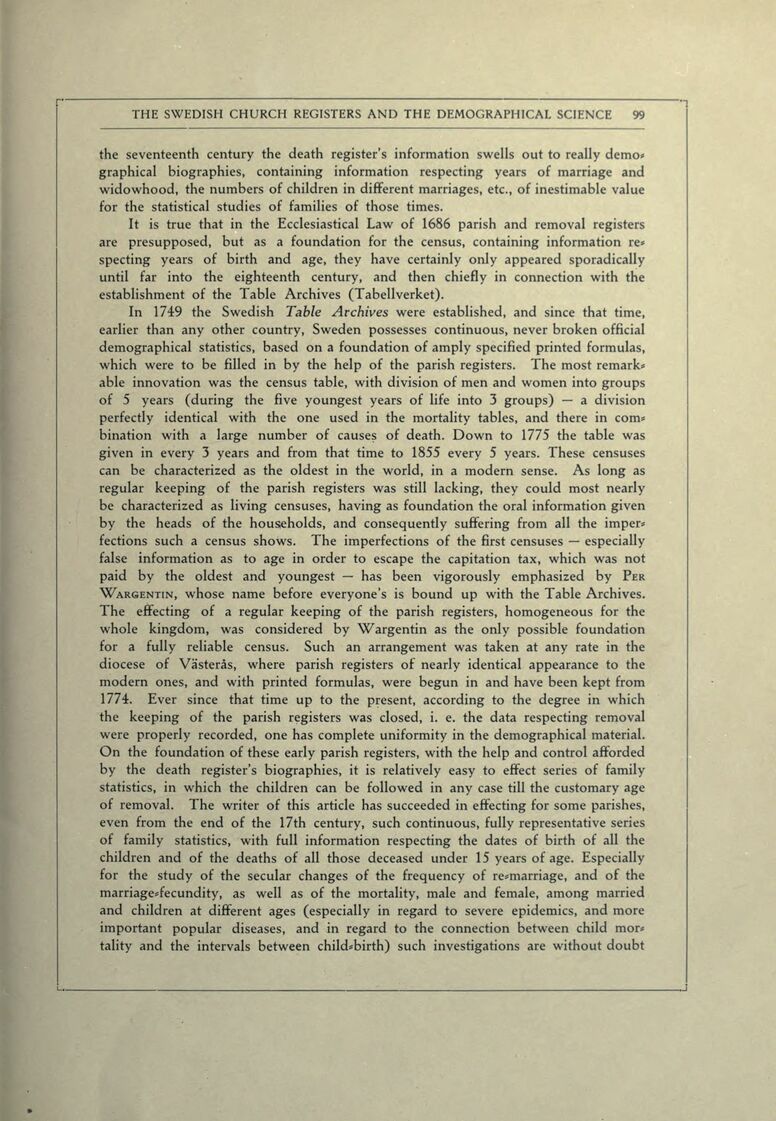
Full resolution (JPEG) - On this page / på denna sida - Part I - Docent Arvid Edin, Uppsala, The Swedish Church Registers and the Demographical Science

<< prev. page << föreg. sida << >> nästa sida >> next page >>
Below is the raw OCR text
from the above scanned image.
Do you see an error? Proofread the page now!
Här nedan syns maskintolkade texten från faksimilbilden ovan.
Ser du något fel? Korrekturläs sidan nu!
This page has never been proofread. / Denna sida har aldrig korrekturlästs.
the seventeenth century the death register’s information swells out to really demo*
graphical biographies, containing information respecting years of marriage and
widowhood, the numbers of children in different marriages, etc., of inestimable value
for the statistical studies of families of those times.
It is true that in the Ecclesiastical Law of 1686 parish and removal registers
are presupposed, but as a foundation for the census, containing information re*
specting years of birth and age, they have certainly only appeared sporadically
until far into the eighteenth century, and then chiefly in connection with the
establishment of the Table Archives (Tabellverket).
In 1749 the Swedish Table Archives were established, and since that time,
earlier than any other country, Sweden possesses continuous, never broken official
demographical statistics, based on a foundation of amply specified printed formulas,
which were to be filled in by the help of the parish registers. The most remark*
able innovation was the census table, with division of men and women into groups
of 5 years (during the five youngest years of life into 3 groups) — a division
perfectly identical with the one used in the mortality tables, and there in com*
bination with a large number of causes of death. Down to 1775 the table was
given in every 3 years and from that time to 1855 every 5 years. These censuses
can be characterized as the oldest in the world, in a modern sense. As long as
regular keeping of the parish registers was still lacking, they could most nearly
be characterized as living censuses, having as foundation the oral information given
by the heads of the households, and consequently suffering from all the imper*
feetions such a census shows. The imperfections of the first censuses — especially
false information as to age in order to escape the capitation tax, which was not
paid by the oldest and youngest — has been vigorously emphasized by Per
Wargentin, whose name before everyone’s is bound up with the Table Archives.
The effecting of a regular keeping of the parish registers, homogeneous for the
whole kingdöm, was considered by Wargentin as the only possible foundation
for a fully reliable census. Such an arrangement was taken at any rate in the
diocese of Västerås, where parish registers of nearly identical appearance to the
modern ones, and with printed formulas, were begun in and have been kept from
1774. Ever since that time up to the present, according to the degree in which
the keeping of the parish registers was closed, i. e. the data respecting removal
were properly recorded, one has complete uniformity in the demographical material.
On the foundation of these early parish registers, with the help and control afforded
by the death register’s biographies, it is relatively easy to effect series of family
statistics, in which the children can be followed in any case till the customary age
of removal. The writer of this article has succeeded in effecting for some parishes,
even from the end of the 17th century, such continuous, fully representative series
of family statistics, with full information respecting the dates of birth of all the
children and of the deaths of all those deceased under 15 years of age. Especially
for the study of the secular changes of the frequency of re*marriage, and of the
marriage*fecundity, as well as of the mortality, male and female, among married
and children at different ages (especially in regard to severe epidemics, and more
important populär diseases, and in regard to the connection between child mor*
tality and the intervals between child*birth) such investigations are without doubt
<< prev. page << föreg. sida << >> nästa sida >> next page >>